|
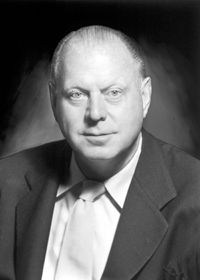
|
Harley Earl - The Corvette was the brainchild of Harley Earl, GM's first design chief. Earl loved sports cars, and he noted that GIs returning from World War II were
bringing home European roadsters. Earl convinced GM's top executives that they needed to build an inexpensive American two-seater.
Originally code-named "Project Opel," the Corvette project was kept under tight wraps in a small studio, where a handful of people worked on it. Initially, Earl wasn't sure which GM division
should sell the Corvette, but he decided to give Ed Cole's Chevrolet Division first shot. Cole knew the first time he saw the prototype that it was just what Chevrolet needed to give the brand a new image.
Earl's Corvette debuted at Motorama in New York, January of 1953 and was an instant hit. Six months later the Corvette went into production.
Harley Earl led GM Design from 1927 - 1958 and was responsible for the Buick Y-Job in 1938, widely considered the industry's first concept car
|
|
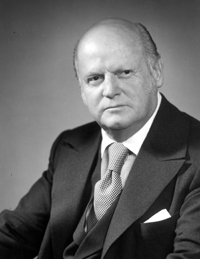
|
Bill Mitchell - Quite possibly one of the greatest automotive designers ever, it's said that Bill Mitchell's influence on the Corvette was as strong as Zora's. As GM's vice president of design, he was Ed Cole's golden boy, and succeeded Ed Cole as chief stylist.
Some of his shining achievements include the legendary 1963 Sting Ray, which he developed to go after Mercedes and Jaguar racecars, and the Mako Shark and Mako Shark II concept cars. The Mako concepts, he said,
were inspired by a shark he caught while deep-sea fishing off the coast of Bimini. Even today, Corvette designers look to Bill Mitchell designs for inspiration.
Bill Mitchell led GM Design from 1958 - 1977. His accomplishments included the design of the 1963 Corvette Stingray and 1963 Buick Riviera
|
|
|
|
|
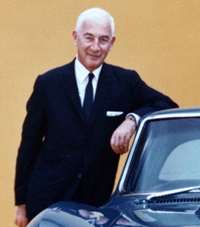
|
Zora Arkus-Duntov - When Zora Arkus-Duntov arrived at GM in May 1953, he had an agenda: to make the Corvette the performer he knew it could be. Arkus-Duntov first saw the Corvette at the 1953 Motorama in New York City, and it so inspired him that he wrote a letter to Ed Cole, sharing his desire to work on the car. His vision, energy and determination shaped the early years of the Corvette legend, and that spirit continues to drive the destiny of the sport coupe even today.
In 1956, an Arkus-Duntov camshaft, mated to Cole's small-block V8, boosted horsepower from 195 to 240, and Arkus-Duntov set a record behind the wheel of this Corvette, doing the Daytona Flying Mile at
150.583 mph. He also set a stock car record when he raced up Pikes Peak in 1956 in a pre-production prototype Chevy. In 1963, Zora launched the legendary Grand Sport program. The idea was to create a special
lightweight Corvette weighing only 1,800 pounds and race it on an international circuit.
By 1968, he'd become chief engineer of Corvette, and helped introduce technology such as disc brakes, independent rear suspension and limited-slip differential. He developed the famous Duntov
high-lift camshaft and helped bring fuel injection to the Corvette in 1957. He also pioneered the CERV experimental research vehicles, a moniker still in use today.
Yet his life in America was just a fraction of the Zora story. Born in Belgium on Christmas Day in 1909, he graduated from the Institute of Charlottenburg in 1934, and started writing engineering
papers for a German publication. In 1939 he married Elfi Wolff, a German native who danced with the Folies-Begère. They later escaped Europe when France surrendered, with Elfi piloting an MG, Nazi troops in close
pursuit, and Zora cloistered in a bordello until the danger subsided. Several days later they set sail for New York. There, Arkus-Duntov and his brother, Yura, started a business that manufactured parts for Ford and
the military. Later, he worked on the Allard sports car in England, co-driving it at Le Mans in '52 and in '53, and then winning class victories at Le Mans in 1954 and 1955 in a 1100cc Porsche Spyder.
Arkus-Duntov retired from GM in 1975, but remained intimately connected to the Corvette culture until his death, just months before the 1997 launch of the fifth-generation model. He was a fixture at
most of the major Corvette gatherings, shows and events, and was always accessible to the car's many loyal owners.
"The one impression I'll cherish is the warmth," said John Cafaro, chief designer for the fifth-generation Corvette. "Zora was held in such high esteem in Corvette and automotive
circles. Yet, he'd sit there for hours and hours signing autographs. He always had time to devote to Corvette lovers."
Passionate, opinionated and brilliant, it's fair to say the Corvette's soul will always belong to Zora.
read more about Zora Arkus-Duntov
|
|
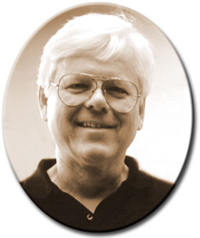
|
Dave McClellan - Six months after staff engineer Dave McClellan joined the Corvette team in 1975, he took on a most daunting challenge when he assumed the role of Corvette chief engineer after Arkus-Duntov's retirement. It didn't help that Corvette's future was uncertain, at best. Caught in the crossfire of tightening federal regulations and the fuel crunch, cars like Corvette were quickly becoming an endangered species. But McClellan, with a strong performance car background at GM, was ready.
Unafraid to push the limits of technology, the 1978 hatchback coupe debuted under his watch, and after that, the fourth-generation Corvette. The first 140 mph Corvette in more than a decade, McClellan
and his team made sure the car met tough speed, handling and aerodynamic criteria in an era of strict regulation, and satisfied legions of Corvette owners in the process.
During McClellan's tenure, he and his team introduced groundbreaking new technologies such as ABS, traction control, passive keyless entry, extended-mobility tires, and air bags, many of which soon
became standard and optional fare on the rest of the Chevy lineup. He also raised the car's horsepower by 50 percent and refined the handling and fuel injection.
In addition, McClellan oversaw Corvette's stunning run in endurance racing. Drivers like Kim Baker, Tommy Morrison, Dick Guldstrand, Doug Rippie and John Powell piloted the Corvettes to win 19 of 19
SCCA endurance races in '85, '86 and '87, until it was dismissed from SCCA competition.
Another major accomplishment for McClellan was the development of the venerable ZR-1, the King of the Hill, a car some believe is the best Corvette in history. He and his team also began the legwork
for the fifth-generation Corvette before the end of his run as chief engineer. Considered a "quiet genius" by many, he retired from GM in 1992 after 17 years at the helm, but not before the 1 millionth
Corvette rolled off the line at the Bowling Green plant in Kentucky.
|
|
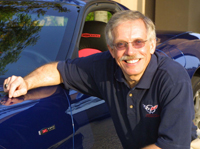
|
Dave Hill - As the third chief engineer in Corvette history, and the present commander-in-chief, Corvette vehicle line executive Dave Hill made a huge statement with the fifth-generation Corvette coupe and convertible, and the over-400hp Z06. Certainly one of the most-anticipated vehicles in the 1990s, the stakes were high for the new Corvette, and Hill delivered a critically acclaimed car that paid homage to the rich heritage, while satisfying modern safety, comfort and performance requirements.
Under his watch, Corvette pioneered the hydroformed frame rail, achieving a lighter, stiffer, better handling vehicle. Hill and his team also made major improvements in visibility, noise, vibration
and harshness, build quality and performance.
He came from Cadillac, where he was chief engineer on Allante, and today he heads up the Cadillac XLR program in addition to fifth and sixth generation Corvette programs.
As the current ambassador of the Corvette legacy, Hill also is very involved in the events and activities the surround the car. A regular at Corvette car shows, races and museum events, Hill is a
celebrated, well-known fixture in the Corvette community.
|
|
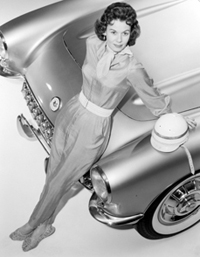
|
Betty Skelton - At the 1956 Speed Weeks runs, just weeks after Zora Arkus-Duntov drove 150 mph at Daytona Beach, Chevrolet fielded a trio of Corvettes, driven by Arkus-Duntov, John Fitch and Betty Skelton. Skelton, an aviatrix and one of the top woman stunt pilots in America at the time, earned a women's speed record of 137.773 mph in the "Flying Mile" production class on the legendary coastline. She also was a spokeswoman of sorts for Chevrolet, appearing at auto shows, racing events and in national advertising. She also was one of the founders and editors of "Corvette News," the precursor to today's "Corvette Quarterly" magazine. Skelton was the first woman to be inducted into the Corvette Hall of Fame.
(photo) Betty Skelton with 1957 Corvette
|
|
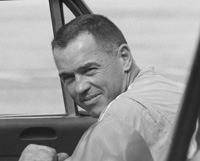
|
Doctor Dick Thompson - The ultimate weekend racer, Dr. Dick Thompson was the leader of a culture of racers whose dream was to buy fast cars and race them with minimal modification. This dentist-turned-driver piloted one of the first Corvettes at Pebble Beach in 1956, finishing first in his class. Later that year, he won the SCCA C-Class national championship, and the following year he took a production Corvette to first place in the GT class, 20 laps ahead of the pack. In 1963, he drove one of the five legendary Corvette Grand Sports to win at Watkins Glen. He worked with GM styling chief Bill Mitchell on the famed Corvette Stingray Racer.
(photo) circa 1960. Dick Thompson is one of the most successful Corvette racers of all time. Beginning in 1956 he raced Corvettes all over America and in various other nations including France, where in 1960 he
and Fred Windridge co-drove the #2 Cunningham Team Corvette at Le Mans. Five of Thompson's nine total SCCA national championships were earned driving Corvettes and he also enjoyed many important race victories in a
Corvette, including the GT title in the 1957 12 Hours of Sebring and the first win in the legendary Corvete Grand Sport.
|
|
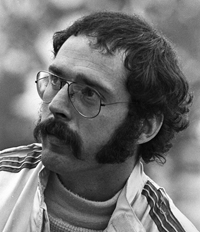
|
John Greenwood - As a young driver in the 1960s and '70s, John Greenwood raced Corvettes at Daytona and LeMans, making him a Corvette legend. He was A-production class champion in '70 and '71. Also in '71, Greenwood teamed up with comedian Dick Smothers and together they won the 12 Hours of Sebring, GT class. He continued to race Corvettes in the SCCA Trans-American Champion series and won the championship in 1975. Today, he modifies cars for ultra high performance, including the Greenwood Turbo Coupe.
|
|
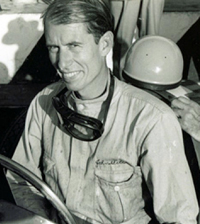
|
John Fitch - Another Corvette racing pioneer, John Fitch was the SCCA's first national champion, and won the second Sebring 12-hour race in 1953. Fitch raced the Corvette test mule that was later transformed into the Sting Ray Racer, as well as the rare Corvette SS. After his retirement, Fitch started the world's first Advanced Driving School, built specialty cars and developed the "Fitch Barriers," the yellow crash barrels seen on racetracks and highways.
|
|
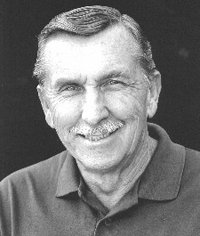
|
Dick Guldstrand - Dick Guldstrand made Corvette his life's work. During the 1950s and '60s, Guldstrand made a name for himself racing and modifying Corvettes. He was often called upon for his expertise behind the wheel and under the hood. His big break came when Roger Penske asked him to modify and drive one of five Corvette Grand Sports in the 1960s. These lightweight racers, designed by Zora Arkus-Duntov, are remembered as icons of the muscle car era, and proof that Corvette could race with the best and win. The original plan was to build 100 to qualify as production stock on the international race circuits, but GM's factory racing ban dictated that Grand Sports only be raced privately. Guldstrand claimed the GT class at the Daytona Continental. Today, he owns Guldstrand Engineering in Culver City, Calif., and produces custom Corvettes.
|
|
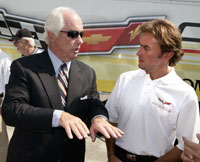
|
Roger Penske - Although today Roger Penske is better known as a CEO and race team owner, at one time he was closely involved with Corvette. While attending Lehigh University, Penske raced a 1957 Corvette at local tracks. He continued his weekend racing pursuits after college, and in 1962 Sports Illustrated named him Driver of the Year. He drove one of the infamous Corvette Grand Sports in 1963, and started his own race team a year later. In his first year of competition in the Grand Sport, he beat the formidable Shelby Cobra at the Nassau Speed Weeks competition to win the tourist trophy.
(photo) Roger Penske (left) describes the Detroit Grand Prix race course to Corvette Racing driver Olivier Beretta at the Corvette Racing Pep Rally on the Riverwalk at the General Motors Renaissance Center in
Detroit, Michigan Tuesday, August 28, 2007. Team Corvette will be racing at Belle Isle on Saturday at the Detroit Grand Prix.
|
|
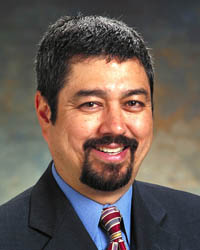
|
John Cafaro - Before joining the Corvette design team, John Cafaro logged many hours designing the Pontiac Fiero and Bonneville and the Chevy Camaro. But his ties to Corvette began much earlier, when, at age eight, he fell in love with Bill Mitchell's Mako Shark concept at the World's Fair in New York. As chief exterior designer and design team leader for the 1997 Corvette, Cafaro said the GTP racecar, the Corvette Indy concept car, and fighter jets influenced him. When the car debuted, his work generated much praise for his ability to blend the Corvette's heritage with a sleek, modern appearance. Since then, he's developed advanced concept vehicles for the 2001 North American International Show, the 2001 Specialty Equipment Manufacturing Association (SEMA) show, and also worked on the Fiero, Trans Am Camaro and C5-R Corvette racing programs. Today he's the director of the full-size truck platform for the H2 HUMMER.
|
|
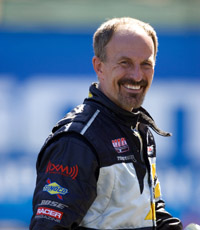
|
John Heinricy - As assistant chief engineer on the fourth-generation and fifth-generation Corvettes and a professional racecar driver, John Heinricy has successfully blended both professions. Today, he is the director of high performance vehicle operations for GM's new performance division. He joined GM in 1970, and spent most of his career with Chevrolet. He became vehicle development manager for the Corvette platform in 1989, and by 1995, he was total vehicle integration engineer for the Corvette. In 1997, he took over as chief engineer for the Camaro and Firebird, and the director of vehicle dynamics for GM cars and trucks in 2001. Heinricy has raced Corvettes, Camaros, and Pontiac Firebirds professionally since 1984 and has won seven driving championships and several team championships. He was a member of the team that broke three world speed records in 1990 driving a Corvette ZR1, and drove one of the C5R Corvette racecars in GT2 competition.
|
|
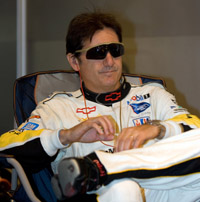
|
Ron Fellows - One of the most versatile drivers in racing today, and arguably one of the best road racers in the world, Canadian Ron Fellows has logged laps in SCCA, NASCAR, American Le Mans Series racing and more. His expertise has helped make the C5-R, Corvette's current racecar, a credible contender in sports car racing and a regular winner at some of racing's most important events. He helped drive the Corvette racecar to two class wins at the 24 Hours of Le Mans, and wins at Sebring, Road Atlanta, Laguna Seca and the Daytona 24-hour race.
(photo) 24 Hours of Le Mans, June 11, 2008, Le Mans, France, C6.R #63 driver Ron Fellows in the pit garage during night practice/qualifying
|
|
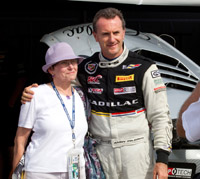
|
Andy Pilgrim - C5-R driver Andy Pilgrim began his racing career in his native England, racing karts, and was an undefeated regional champion in 1977. He moved to the US 1981 and started racing cars in 1984. Since joining the Corvette racing team several years ago, he has achieved back-to-back wins, three podium finishes at Le Mans and numerous wins in North American championships. In addition, Pilgrim's unbeaten world record of 116 consecutive race finishes in IMSA / PSCR events is unprecedented. Off track, Pilgrim drives a fifth-generation production Corvette.
(photo) Cadillac Racing, SCCA Pro Racing World Challenge, Road Atlanta in Braselton, Georgia. September 30, 2011. In the final event of the 2011 season Johnny O'Connell earned pole position and led every lap of
the race on the way to victory in the GT class. Andy Pilgrim also earned a podium position after driving the #8 Cadillac CTS-V Coupe Racecar to 3rd in GT
|
|
|
|
|














